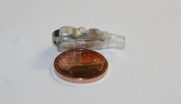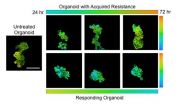Pair bonding reinforced in the brain
Zebra finches use their specialised song system for simple communication
2014-10-28
(Press-News.org) This news release is available in German.
In addition to their song, songbirds also have an extensive repertoire of calls. While the species-specific song must be learned as a young bird, most calls are, as in the case of all other birds, innate. Researchers at the Max Planck Institute in Seewiesen have now discovered that in zebra finches the song control system in the brain is also active during simple communication calls. This relationship between unlearned calls and an area of the brain responsible for learned vocalisations is important for understanding the evolution of song learning in songbirds.
Almost half of all bird species are songbirds. Only they have the ability to learn complicated vocal patterns which are described generally as song. Several studies prove that the songs of songbirds serve mainly to select a partner and defend a territory. In the temperate zones of the Northern hemisphere, usually only the male birds sing.
However, all birds, both male and female, have calls - including species such as the zebra finch, where the female never sings. Apart from a few exceptions, the calls do not have to be learned and are used for communication purposes.
They are mostly associated with a specific purpose as in the case of alarm calls and contact calls, for example. The songbird's song is of great interest for neurobiologists as it is controlled by a network of nuclei in the forebrain. Neuroscientists study this network to investigate general rules that determine how the brain controls behaviour.
Using specially designed methods to record song and brain activity, a team of researchers at the Max Planck Institute for Ornithology in Seewiesen has now found the neuronal basis of unlearned call communication. The researchers developed ultra-light microphone transmitters which they attached with rubber bands to the backs of zebra finch couples like rucksacks. They also attached a wireless recording system to the males to measure brain activity.
Thanks to this miniature telemetry technology, the animals could move freely in groups in large aviaries so that the scientists were able to continuously register the animals' entire behavioural repertoire. In their experiment, the researchers concentrated on so-called "stack" calls. They discovered that these calls mainly promote cohesion between males and females within bonded pairs. "Constant contact with a partner is important, as the zebra finches live in large social groups," says Lisa Trost, co-author of the study.
Surprisingly, not every call produces an answer in the partner, which initially presented the researchers with a problem during the analysis. They determined that a call from a partner only qualifies as an answer if it is made within two seconds. "We were thus able to create a matrix that clearly showed that almost without exception the two partners exchange calls with one another, which underlines the important social component of this 'stack' call," says Andries Ter Maat, lead author of the study.
When the researchers analysed the activity in an area of the brain that is important for the production of song – an area known as nucleus RA – they found a clear correlation between its activity pattern and the occurrence of the "stack" call. "This connection between an innate call and the activity of a brain area important to learned vocalisations suggests that during the evolution of songbirds, the role of the song area in the brain changed from being a simple vocalisation system for innate calls to a specialised neural network for learned songs," concludes Manfred Gahr, coordinator of the study.
INFORMATION:
Original paper:
Andries Ter Maat, Lisa Trost, Hannes Sagunsky, Susanne Seltmann, Manfred Gahr
Zebra finch mates use their forebrain song system in unlearned call communication
PLoS One, Volume 9, Issue 10, e109334
[Attachments] See images for this press release:


ELSE PRESS RELEASES FROM THIS DATE:
2014-10-28
JUPITER, FL, October 28, 2014 – Scientists from the Florida campus of The Scripps Research Institute (TSRI) have uncovered a major contributor to Huntington's disease, a devastating progressive neurological condition that produces involuntary movements, emotional disturbance and cognitive impairment.
Using an animal model of Huntington's disease, the new study shows that signaling by a specific protein can trigger onset of the disease and lead to exacerbation of symptoms. These findings, published in the October 28, 2014 issue of the journal Science Signaling, offer ...
2014-10-28
A connection between inflammation and cancer has been recognized for over a hundred years. This connection is particularly evident in colon carcinogenesis, because patients with IBD have a higher incidence of colon cancer than the general population. There is increasing evidence that inflammation contributes to the earliest stages of carcinogenesis, namely in the process of cell transformation, where the cell acquires many aspects of cancer characteristics. The observation that IBD and colon cancer incidence rise as nations industrialize suggests that changes in diet and ...
2014-10-28
PROVIDENCE, R.I. [Brown University] — New research by physicists from Brown University puts the profound strangeness of quantum mechanics in a nutshell — or, more accurately, in a helium bubble.
Experiments led by Humphrey Maris, professor of physics at Brown, suggest that the quantum state of an electron — the electron's wave function — can be shattered into pieces and those pieces can be trapped in tiny bubbles of liquid helium. To be clear, the researchers are not saying that the electron can be broken apart. Electrons are elementary particles, ...
2014-10-28
Politics can have unintentional evolutionary consequences that may cause hastily issued policies to cascade into global, multigenerational problems, according to political scientists.
"Most western democracies look at policies as if they are bandages, we fix what we can and then move on," said Pete Hatemi, associate professor of political science, Penn State. "But we need to consider generational policies so that we can fix what we can now, but also be prepared for what comes next."
The researchers said that there is an interaction between political and cultural forces ...
2014-10-28
WASHINGTON, D.C., October 28, 2014 – In the future, computers may be capable of talking to us during meetings just like a remote teleconference participant. But to help move this science-fiction-sounding goal a step closer to reality, it's first necessary to teach computers to recognize not only the words we use but also the myriad meanings, subtleties and attitudes they can convey.
During the 168th Meeting of the Acoustical Society of America (ASA), to be held October 27-31, 2014, at the Indianapolis Marriott Downtown Hotel, Valerie Freeman, a Ph.D. candidate in ...
2014-10-28
One of the tragic realities of cancer is that the drugs used to treat it are highly toxic and their effectiveness varies unpredictably from patient to patient. However, a new "tumor-in-a-dish" technology is poised to change this reality by rapidly assessing how effective specific anti-cancer cocktails will be on an individual's cancer before chemotherapy begins.
A team of biomedical engineers at Vanderbilt University headed by Assistant Professor Melissa Skala has developed the technique, which uses fluorescence imaging to monitor the response of three-dimensional chunks ...
2014-10-28
Tropical Cyclone Nilofar developed an eye on Oct. 28 that seemed to stare at NASA's Terra satellite as it passed overhead in space. Warnings are already in effect from the India Meteorological Department as Nilofar is forecast to make landfall in northwestern India.
On Oct. 28 at 06:50 UTC (2:50 a.m. EDT) the MODIS instrument aboard Terra captured a visible image of Tropical Cyclone Nilofar after it developed an eye while moving north in the Arabian Sea. The 12 nautical mile (13.8 miles/22.2 km) wide eye was surrounded by powerful thunderstorms and bands of thunderstorms ...
2014-10-28
DEET has been the gold standard of insect repellents for more than six decades, and now researchers led by a University of California, Davis, scientist have discovered the exact odorant receptor that repels them.
They also have identified a plant defensive compound that might mimic DEET, a discovery that could pave the way for better and more affordable insect repellents. Findings from the study appear in the journal Proceedings of the National Academy of Sciences.
More than 200 million people worldwide use DEET, developed by scientists at the U.S. Department of Agriculture ...
2014-10-28
Nitrogen is an essential component of all living systems, playing important roles in everything from proteins and nucleic acids to vitamins. It is the most abundant element in Earth's atmosphere and is literally all around us, but in its gaseous state, N2,, it is inert and useless to most organisms. Something has to convert, or "fix," that nitrogen into a metabolically usable form, such as ammonia. Until about 100 years ago when an industrial-scale technique called the Haber-Bosch process was developed, bacteria were almost wholly responsible for all nitrogen fixation on ...
2014-10-28
Boulder, Colo., USA - Mountain glaciers represent one of the largest repositories of fresh water in alpine regions. However, little is known about the processes by which water moves through these systems. In this study published in Geology on 24 Oct. 2014, David S. Heeszel and colleagues use seismic recordings collected near Lake Gornersee in the Swiss Alps to look for signs of water moving through fractures near the glacier bed. Analysis of these recordings reveals, for the first time, that harmonic tremor occurs within mountain glaciers and that individual icequakes at ...
LAST 30 PRESS RELEASES:
[Press-News.org] Pair bonding reinforced in the brain
Zebra finches use their specialised song system for simple communication





